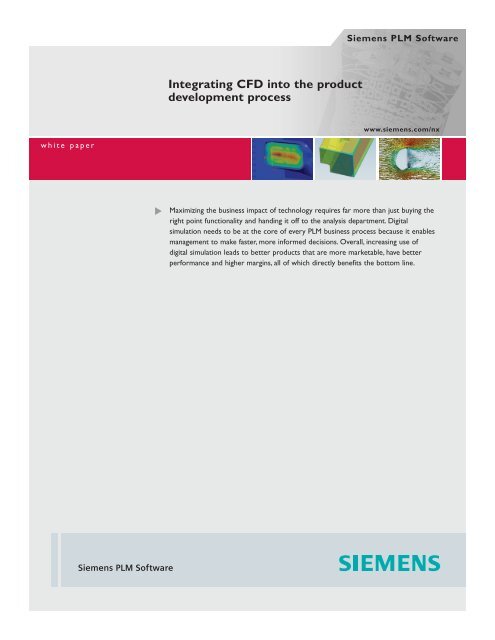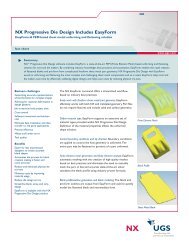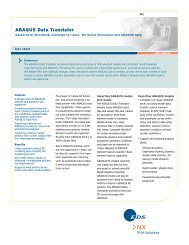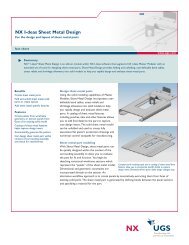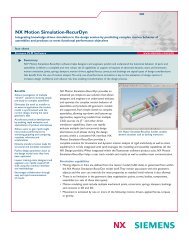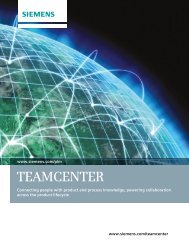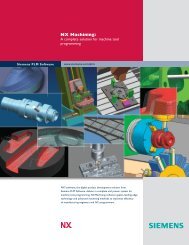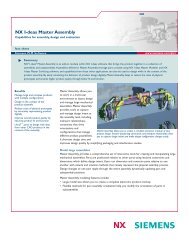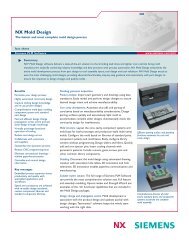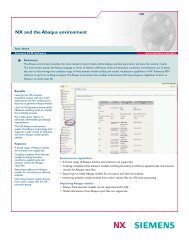Integrating CFD into the product development process - Industrial ...
Integrating CFD into the product development process - Industrial ...
Integrating CFD into the product development process - Industrial ...
You also want an ePaper? Increase the reach of your titles
YUMPU automatically turns print PDFs into web optimized ePapers that Google loves.
Siemens PLM Software<br />
<strong>Integrating</strong> <strong>CFD</strong> <strong>into</strong> <strong>the</strong> <strong>product</strong><br />
<strong>development</strong> <strong>process</strong><br />
www.siemens.com/nx<br />
w h i t e p a p e r<br />
Maximizing <strong>the</strong> business impact of technology requires far more than just buying <strong>the</strong><br />
right point functionality and handing it off to <strong>the</strong> analysis department. Digital<br />
simulation needs to be at <strong>the</strong> core of every PLM business <strong>process</strong> because it enables<br />
management to make faster, more informed decisions. Overall, increasing use of<br />
digital simulation leads to better <strong>product</strong>s that are more marketable, have better<br />
performance and higher margins, all of which directly benefits <strong>the</strong> bottom line.<br />
Siemens PLM Software
<strong>Integrating</strong> <strong>CFD</strong> <strong>into</strong> <strong>the</strong> <strong>product</strong> <strong>development</strong> <strong>process</strong><br />
Table of contents<br />
Executive summary 1<br />
Introduction 2<br />
NX Flow for <strong>CFD</strong> 3<br />
NX Flow technology 5<br />
Integration with <strong>the</strong> <strong>product</strong><br />
<strong>development</strong> <strong>process</strong> 8<br />
Summary 9
Executive summary<br />
Computational fluid dynamics (<strong>CFD</strong>) allows engineers to numerically solve<br />
very complex analyses that describe and predict <strong>the</strong> flow of air, gases or<br />
liquids around or through a body or within an enclosed system. Analyzing <strong>the</strong><br />
flow patterns and pressure regulation of fluid within an automotive<br />
transmission and <strong>the</strong> flow of air within an HVAC system are two typical<br />
examples of <strong>CFD</strong> applications.<br />
Traditionally, <strong>CFD</strong> has been considered a tedious and time-consuming<br />
<strong>process</strong> performed exclusively by PhD specialists and, in many industries, not<br />
part of a company’s mainstream <strong>product</strong> <strong>development</strong> strategy. More<br />
recently, computer-aided engineering (CAE) has taken on a greater level of<br />
importance within <strong>the</strong> <strong>product</strong> lifecycle management (PLM), and <strong>the</strong><br />
increasing use of CAE is being credited for <strong>the</strong> <strong>development</strong> of higher<br />
quality, more marketable <strong>product</strong>s. In turn, <strong>the</strong>se innovative <strong>product</strong>s feature<br />
much increased performance and profit margins, all of which directly<br />
benefits a company’s bottom line. As such, varying types of CAE analyses –<br />
including <strong>CFD</strong> – are moving fur<strong>the</strong>r upstream in <strong>the</strong> digital <strong>product</strong><br />
<strong>development</strong> <strong>process</strong>.<br />
This paper describes <strong>the</strong> benefits of incorporating <strong>CFD</strong> as well as coupled<br />
<strong>the</strong>rmal/flow solutions <strong>into</strong> an integrated PLM environment and specifically<br />
discusses <strong>the</strong> capabilities of NX ® Flow software – <strong>the</strong> new design-integrated<br />
<strong>CFD</strong> solution from Siemens PLM Software.<br />
1
Introduction<br />
Various surveys and articles have recently been published on <strong>the</strong> topic<br />
of computational fluid dynamics (<strong>CFD</strong>).The consensus is that<br />
companies are facing multiple challenges in attempting to incorporate<br />
<strong>CFD</strong> engineering analysis earlier and throughout <strong>the</strong> <strong>product</strong><br />
<strong>development</strong> <strong>process</strong>.The integration of <strong>CFD</strong>, like any o<strong>the</strong>r<br />
engineering analysis technology (such as <strong>the</strong>rmal or structural), relies<br />
on <strong>the</strong> ability to quickly go from a concept design based on detailed<br />
3D geometry to a discrete representation of <strong>the</strong> simulation model,<br />
complete with associated physical boundary conditions; and ultimately<br />
to <strong>the</strong> performance simulation results. In addition, <strong>the</strong> iterative nature<br />
of <strong>the</strong> <strong>product</strong> <strong>development</strong> <strong>process</strong> calls for associativity between <strong>the</strong><br />
3D CAD part geometry as well as <strong>the</strong> assembly data and <strong>the</strong><br />
simulation model representation.<br />
Regardless of <strong>the</strong> challenges, <strong>CFD</strong> can play a very beneficial role in<br />
<strong>product</strong> <strong>development</strong> for specific applications that are dependent on<br />
<strong>the</strong> physics of fluid flow. More specifically, <strong>CFD</strong> can help reduce or<br />
eliminate costly prototypes. As a prediction solution, <strong>CFD</strong> analyses are<br />
valuable in evaluating multiple ‘what if’ scenarios in an effort to obtain<br />
an optimal design alternative. <strong>CFD</strong> analysis can help reduce design<br />
cycle time without compromising quality by pinpointing fluid flow and<br />
<strong>the</strong>rmo-fluid related design flaws through digital simulation early in <strong>the</strong><br />
design <strong>process</strong>.<br />
2
NX Flow for <strong>CFD</strong><br />
NX Flow offers a comprehensive suite of <strong>CFD</strong> capabilities for high<br />
accuracy simulation of fluid flow. NX Flow provides a complete<br />
framework for modeling and solving complex fluid flow problems by<br />
virtue of being fully embedded in <strong>the</strong> NX environment. It supports fully<br />
unstructured meshes, which can be generated using <strong>the</strong> NX finite<br />
element modeling environment or a built-in meshing tool capable of<br />
generating skin meshes for better resolution of near-wall effects and<br />
convective heat transfer. It also supports fully disjoint meshes across<br />
adjoining fluid volumes. Flow blockages can be modeled using 2D or<br />
3D solid elements, with arbitrary porosity (including orthotropic),<br />
surface roughness and convective attributes. NX Flow can be used in<br />
tandem with <strong>the</strong> NX Thermal <strong>product</strong> for seamless modeling of fully<br />
coupled forced and natural convection problems, including radiation<br />
heat transfer. Flow boundary conditions are easily modeled, including<br />
fan curves, time-varying inlet and outlet conditions, internal fans and<br />
fluid recirculation loops. NX Flow offers a variety of turbulence models<br />
for fluid flow modeling, including mixing length and k-ε models; secondorder<br />
schemes are available for momentum, energy and turbulence.<br />
The <strong>product</strong> enables effective simulation of both steady-state and<br />
transient fluid flow problems, with effective handling of conjugate heat<br />
transfer problems. NX Flow features an advanced and efficient<br />
algebraic multigrid solver, ensuring a rapid and reliable solution.<br />
A comprehensive set of post-<strong>process</strong>ing tools is provided within <strong>the</strong><br />
NX environment.<br />
As a result, NX Flow is a general-purpose <strong>CFD</strong> simulation package. Its<br />
streamlined <strong>CFD</strong> modeling tools are fully integrated <strong>into</strong> <strong>the</strong> NX<br />
digital <strong>product</strong> <strong>development</strong> environment; <strong>the</strong>refore, NX Flow<br />
automatically recognizes NX CAD geometry and assembly changes by<br />
adapting <strong>the</strong> fluid domain instantaneously. By operating within <strong>the</strong> NX<br />
CAD environment, NX Flow is fully parametric.With NX Flow, <strong>the</strong><br />
<strong>CFD</strong> fluid domain needs to be defined only once.The local mesh seeds<br />
on solid parts or surfaces and <strong>the</strong> boundary layer mesh need only to<br />
be defined once if required.<br />
As soon as <strong>the</strong> NX Flow solver is launched, <strong>the</strong> user can continue<br />
working with NX (<strong>the</strong> user can continue to work on <strong>the</strong> next design<br />
or simulation task while <strong>the</strong> <strong>CFD</strong> simulation results are being<br />
generated). A window will inform <strong>the</strong> user of solution status and<br />
completion.The user can also bring up <strong>the</strong> solver monitor form at any<br />
point in time to check on status of <strong>the</strong> simulation solution and various<br />
parameters such as convergence plots, minimum and maximum<br />
pressure, velocity and temperature.<br />
In a Teamcenter ® managed <strong>development</strong> environment, NX Flow’s<br />
integration with <strong>the</strong> design <strong>process</strong> brings to bear flexible and powerful<br />
tools for multiple positioning of parts and optimizing of shapes,<br />
allowing <strong>the</strong> creation of multiple <strong>CFD</strong> results sets to increase your<br />
<strong>product</strong>’s performance parameters.<br />
NX Flow is a <strong>CFD</strong> solver that computes <strong>the</strong> solution to <strong>the</strong> Navier-<br />
Stokes equations, which are nonlinear, coupled, partial differential<br />
equations for <strong>the</strong> conservation of fluid mass, energy and momentum in<br />
general and complex 3D geometry. It uses an element-based finite<br />
volume method to discretize <strong>the</strong> solution fluid domain and an algebraic<br />
multigrid method to solve <strong>the</strong> governing equations.What does that<br />
mean? The NX Flow application breaks up <strong>the</strong> fluid volume <strong>into</strong> a large<br />
number of well-defined smaller elements or blocks for which <strong>the</strong><br />
equations of physical behavior are well understood and can be solved<br />
in <strong>the</strong> software.<br />
NX Flow tackles industry-specific challenges such as:<br />
• <strong>Industrial</strong> applications: design of pipes, valves and hydraulic<br />
components<br />
• Automotive: cabin climate control systems, powertrain or<br />
automotive transmission, under hood cooling, exhaust systems<br />
• Electronics: packaging and system-level analyses, air and liquid cooled<br />
devices<br />
• Medical devices: liquid cooling, viscous flows, etc.<br />
• Military and defense applications: electronics enclosures to nozzle<br />
designs<br />
• Aircraft and avionics systems: cabin ventilation systems, cooling<br />
systems, etc.<br />
3
NX Flow for <strong>CFD</strong> (continued)<br />
NX Flow solves practical engineering challenges such as:<br />
• Computing pressure and velocity fields within and around complex<br />
geometries<br />
• Optimizing <strong>the</strong> placement of critical components<br />
• Investigating both forced and natural convection cooling schemes<br />
• Initial sizing of wing profiles, critical car component shapes and o<strong>the</strong>r<br />
components or large assemblies<br />
• Determining drag lift or o<strong>the</strong>r forces and pressures acting on<br />
complex surfaces<br />
• Designing of air comfort systems (HVAC cabin design)<br />
• Predicting <strong>the</strong> operating point of a cooling fan<br />
• Positioning and sizing of fans, inlets, vents and outlets<br />
• Establishing spacing requirements between parts<br />
• Optimizing <strong>the</strong> size and shape of heat sinks or designing <strong>the</strong> best<br />
fluid pipe pattern throughout a complex assembly<br />
4
NX Flow technology<br />
Thermal couplings for joining disjoint solid or surface<br />
meshes<br />
Complex assemblies of parts with dissimilar mesh can be <strong>the</strong>rmally<br />
connected through <strong>the</strong>rmal couplings. Creating <strong>the</strong>se heat paths from<br />
disjoint and dissimilar meshes is totally changing <strong>the</strong> paradigms for<br />
<strong>CFD</strong> and <strong>the</strong>rmo-fluid simulation modeling.The easy-to-use modeling<br />
technique allows <strong>the</strong> engineer to create area-proportional<br />
conductances between dissimilar element meshes where complicated<br />
connections or CAD modifications had to be made.The conductances<br />
are established at runtime where a variety of different conductance<br />
types are created from <strong>the</strong> <strong>the</strong>rmal coupling parameters defined by<br />
<strong>the</strong> user.The couplings can even be defined as varying with different<br />
model parameters such as temperatures or heat loads determined<br />
during <strong>the</strong> solution.<br />
Automatically joining disjoint fluid meshes<br />
The ability to automatically join disjoint fluid meshing at runtime is a<br />
powerful tool for reducing meshing effort and model sizes.The<br />
technique is conceptually simple and consists of building and meshing<br />
two or more subassemblies or versions of <strong>the</strong> same part of an<br />
assembly so that <strong>the</strong>y share one or more fluid mesh boundaries with<br />
<strong>the</strong> remainder of <strong>the</strong> model.There is no need for nodes to match, but<br />
mesh density on <strong>the</strong> matching faces should be similar.Within an NX<br />
assembly, this method allows NX part models to be changed<br />
instantaneously. A simple toggle called “Connect disjoint meshes” is<br />
provided within <strong>the</strong> flow solver additional options form to enable<br />
joining <strong>the</strong> disjoint fluid meshes at runtime.This meshing technique<br />
embedded within <strong>the</strong> solver is extremely powerful and offers<br />
significant time-savings when trying out different cooling heat sink<br />
designs or optimizing <strong>the</strong> shape or CAD features of a specific part<br />
within <strong>the</strong> assembly without having to remesh <strong>the</strong> entire model.<br />
Viscous models<br />
The first step before running any <strong>CFD</strong> analysis solution is to select a<br />
viscous model for <strong>the</strong> flow analysis. NX Flow features a laminar flow<br />
model, along with a variety of turbulent models. If <strong>the</strong> model is<br />
turbulent, you can select <strong>the</strong> mixing length (algebraic), K-epsilon<br />
(two-equation) or fixed turbulent viscosity models and <strong>the</strong>n specify<br />
<strong>the</strong> appropriate length scales options as needed. Choosing <strong>the</strong><br />
appropriate viscous model will dictate <strong>the</strong> accuracy of <strong>the</strong> fluid flow<br />
results and is an important step to understand.The NX Flow help<br />
page, “Defining <strong>the</strong> Viscous Model”, will guide <strong>the</strong> user with <strong>the</strong> selection<br />
of laminar over turbulent models and determine which turbulent<br />
viscous model to use and how to specify length scales options if<br />
needed.<br />
Modeling fluid buoyancy and natural convection<br />
Modeling fluid buoyancy is essential for natural convection simulation.<br />
Fluid density affects <strong>the</strong> total gravitational force on a volume of fluid,<br />
The value of <strong>CFD</strong> at Cisco Systems<br />
The Network-to-Users Business Unit of Cisco<br />
Systems faces a continual challenge of heat<br />
dissipation requirements affecting <strong>the</strong>ir <strong>product</strong><br />
<strong>development</strong> initiatives. Physical prototyping is<br />
expensive and testing is time consuming.With an<br />
integrated <strong>CFD</strong> solution, Cisco’s engineers have<br />
complete control over <strong>the</strong> analysis models and<br />
modifications can be done quickly and efficiently.<br />
They know from experience that by using <strong>CFD</strong><br />
<strong>the</strong>y can come within 10 percent accuracy of<br />
physical test models; and early prototyping and<br />
weeks of testing can be shortened significantly.<br />
Final physical prototypes are built and tested only<br />
at <strong>the</strong> end of <strong>the</strong> design cycle and serve as<br />
verification ra<strong>the</strong>r than design purposes. Cisco<br />
relies on <strong>CFD</strong> 100 percent for design purposes.<br />
5
NX Flow technology (continued)<br />
such that spatial variations in fluid density give rise to so-called<br />
buoyancy forces. NX Flow allows solving for model fluid buoyancy for<br />
natural convection or mixed forced-natural convection flow<br />
simulations.The buoyancy model simulates <strong>the</strong> effects of gravity on <strong>the</strong><br />
fluid using <strong>the</strong> Boussinesq approximation.<br />
Creating surfaces that automatically convect heat to<br />
<strong>the</strong> fluid<br />
The flow surfaces modeling technique enables <strong>the</strong> modeling of<br />
convection on <strong>the</strong>rmal model surfaces, to or from <strong>the</strong> fluid flow<br />
domain, as well as surface drag on <strong>the</strong> fluid. NX Flow solves <strong>the</strong><br />
<strong>the</strong>rmal (conduction) model and <strong>the</strong> fluid flow model individually.The<br />
solution is <strong>the</strong>rmally coupled (by convection) at <strong>the</strong> solid/fluid<br />
interface defined by flow surfaces; <strong>the</strong>refore, at least one flow surface<br />
is required for a coupled flow-<strong>the</strong>rmal model. Use flow surfaces to<br />
model geometry faces that constrain or direct <strong>the</strong> fluid flow (such as<br />
PC boards, baffles, ducts, chambers, walls, external complex geometry,<br />
etc.) with or without convection. During model simulation, heat paths<br />
or conductances are automatically established from <strong>the</strong> surfaces and<br />
obstructions to adjacent 3D fluid flow elements.The NX Flow solver<br />
splits <strong>the</strong> fluid mesh at <strong>the</strong> embedded flow surface, automatically<br />
creating a 3D obstruction to <strong>the</strong> fluid flow. Moreover, <strong>the</strong> built-in<br />
meshing tools allow for generation of skin meshes (also called<br />
boundary layer meshes) on surfaces for better resolution of near-wall<br />
effects such as drag and convective heat transfer.The combination of<br />
<strong>the</strong> flow surfaces modeling technique and skin meshing capability is<br />
providing a complete set of tools to accurately model <strong>the</strong> near-wall<br />
effects for multiple <strong>the</strong>rmo-fluid interaction applications.<br />
Auto-convect from all surfaces to <strong>the</strong> fluid<br />
Auto-convect allows NX Flow users to avoid unnecessary repetition<br />
of flow surface entities (and convecting flow blockages) that have<br />
identical surface properties.When this option is selected, all surfaces<br />
that are meshed having <strong>the</strong>rmal solid material properties (2D or 3D)<br />
and not already defined as flow surfaces (nor any o<strong>the</strong>r fluid boundary<br />
conditions), are automatically treated as flow surfaces by <strong>the</strong> NX Flow<br />
solver.Thus, <strong>the</strong>se surfaces will convect to <strong>the</strong> fluid elements <strong>the</strong>y<br />
adjoin. Similarly, all volumes that are meshed with nonfluid 3D meshes<br />
and not already defined as flow blockages will automatically model<br />
convection from <strong>the</strong>ir surfaces.Thus, <strong>the</strong>ir surfaces will convect to <strong>the</strong><br />
fluid elements <strong>the</strong>y adjoin.You can define one surface property to be<br />
used for all <strong>the</strong>se convecting surfaces or specify that <strong>the</strong> default<br />
(smooth) surface property be used for all surfaces.<br />
The value of <strong>CFD</strong> at Noranda Technology Centre<br />
Noranda is a leading supplier of zinc for<br />
galvanized steel <strong>product</strong>s used to build homes,<br />
automobiles and consumer goods. Noranda uses<br />
<strong>CFD</strong> to quickly investigate various galvanizing bath<br />
configurations as well as flow scenarios around <strong>the</strong><br />
snout area.The snout is a critical location where<br />
<strong>the</strong> steel first comes <strong>into</strong> contact with <strong>the</strong> zinc<br />
bath. <strong>CFD</strong> enables Noranda to see how <strong>the</strong> flow<br />
develops near <strong>the</strong> strip surface. Modeling <strong>the</strong><br />
boundary layer is important for understanding<br />
diffusion of aluminum from <strong>the</strong> zinc onto <strong>the</strong> steel<br />
surface in order to control <strong>the</strong> reaction between<br />
<strong>the</strong> iron and zinc.<br />
6
NX Flow technology (continued)<br />
Automatic runtime meshing<br />
The fluid domain can simply be picked as a general volume surrounding<br />
all o<strong>the</strong>r parts without having to actually mesh <strong>the</strong> fluid volume. All that<br />
needs to be meshed are <strong>the</strong> internal solid (nonfluid) components (using<br />
ei<strong>the</strong>r 2D mesh on surfaces or 3D mesh on solid components within<br />
<strong>the</strong> fluid volume).The picking of <strong>the</strong> fluid volume is done during <strong>the</strong><br />
application of boundary conditions such as <strong>the</strong> inlet and outlet<br />
conditions.The fluid mesh is <strong>the</strong>n created at runtime using advanced<br />
meshing technology. The NX meshing tools can obviously be leveraged<br />
to mesh <strong>the</strong> fluid volume prior to runtime as well.The combination of<br />
both options provides true fluid domain meshing flexibility and an<br />
automatic and instantaneous way for <strong>the</strong> skilled engineer to investigate<br />
different fluid flow scenarios by moving parts around or modifying<br />
some features within <strong>the</strong> selected fluid domain without having to<br />
remesh <strong>the</strong> fluid volume unnecessarily.This automatic fluid domain<br />
meshing capability is introduced specifically for NX Flow and is a great<br />
<strong>CFD</strong> model preparation time saver for iterative designs and <strong>CFD</strong><br />
scenario investigations.<br />
Interdisciplinary interaction simulations<br />
The coupling of <strong>the</strong>rmal and structural models for conducting a<br />
structural <strong>the</strong>rmo-elastic analysis can be greatly simplified by virtue of<br />
having <strong>the</strong> <strong>the</strong>rmal and structural models sharing <strong>the</strong> same NX<br />
environment tools and user interface, a common design database and<br />
<strong>the</strong> same advanced simulation toolset.The coupling of <strong>the</strong>rmal and fluid<br />
flow models occurs automatically when NX Flow is used in conjunction<br />
with NX Thermal (Siemens PLM Software’s solution for <strong>the</strong>rmal<br />
analysis). A temperature mapping algorithm can be used to map steadystate<br />
or transient NX Flow temperature results onto ano<strong>the</strong>r finite<br />
element model with a different mesh.This technology allows <strong>the</strong><br />
transfer of <strong>the</strong>rmal model results data onto an independent structural<br />
model of similar geometry for <strong>the</strong>rmal stress and distortion analysis.<br />
Similarly, fluid pressures and forces can be mapped onto <strong>the</strong> structural<br />
model for quasi-static or transient stress and distortion analysis.<br />
7
Integration with <strong>the</strong> <strong>product</strong> <strong>development</strong> <strong>process</strong><br />
It is a common situation that companies use multiple CAE systems<br />
from different software vendors for simulating different disciplines; a<br />
simple example is structural and fluid simulation applications. One of<br />
<strong>the</strong> most common (but often forgotten or taken for granted) linking of<br />
different applications is <strong>the</strong> comparison of physical test results against<br />
<strong>the</strong> <strong>the</strong>oretical analysis assumptions.<br />
Sometimes <strong>the</strong>se different disciplines can be treated independently, but<br />
more often <strong>the</strong>y are linked in some way.This can be achieved by using<br />
built-in multi-physics applications, linking of solvers using message<br />
passing interface (MPI) techniques and often customers create <strong>the</strong>ir<br />
own techniques to transfer data between applications. However, in<br />
many cases <strong>the</strong> link between applications or solvers is not so tightly<br />
defined.<br />
All of <strong>the</strong>se situations are part of <strong>the</strong> <strong>product</strong> <strong>development</strong> lifecycle<br />
and are considered to be PLM issues. Using NX Flow and o<strong>the</strong>r CAE<br />
applications that are tightly coupled within <strong>the</strong> PLM context and NX<br />
digital <strong>product</strong> <strong>development</strong> environment will ultimately yield<br />
significant time and cost savings as well as innovative <strong>product</strong>s.<br />
8
Summary<br />
The traditional “experts only” domain of <strong>CFD</strong> and coupled<br />
flow/<strong>the</strong>rmal technology is making its way <strong>into</strong> <strong>the</strong> mainstream of<br />
digital <strong>product</strong> <strong>development</strong>.Advances in CAD integration, automated<br />
geometry abstraction and meshing algorithms and high-performance<br />
solvers that take advantage of <strong>the</strong> rapid advances in desktop computer<br />
power will soon lead to a much higher utilization of flow and multiphysics<br />
performance simulations earlier in <strong>the</strong> <strong>product</strong> design <strong>process</strong>.<br />
This increased adoption rate for <strong>CFD</strong> tools over <strong>the</strong> next 5-10 years<br />
will be similar to <strong>the</strong> significant advancements experienced in<br />
mainstream structural analysis tools such as Nastran over <strong>the</strong> past<br />
decade.<br />
In addition, new knowledge-enabled “<strong>process</strong>-centric” user<br />
environments for non-expert design engineers that leverage <strong>the</strong><br />
expertise and best practices of CAE/<strong>CFD</strong> domain experts will lead to<br />
a much broader utilization of digital performance simulation in <strong>the</strong><br />
context of PLM.The business impact will be substantial to those<br />
companies that leverage <strong>the</strong>se new CAE tools as a strategic<br />
competitive advantage in new <strong>product</strong> <strong>development</strong>.<br />
9
About Siemens PLM Software<br />
Siemens PLM Software, a business unit of<br />
Siemens Industry Sector, is a leading global<br />
provider of <strong>product</strong> lifecycle management (PLM)<br />
software and services with 4.6 million licensed<br />
seats and 51,000 customers worldwide.<br />
Headquartered in Plano,Texas, Siemens PLM<br />
Software’s open enterprise solutions enable a<br />
world where organizations and <strong>the</strong>ir partners<br />
collaborate through Global Innovation Networks to<br />
deliver world-class <strong>product</strong>s and services. For more<br />
information on Siemens PLM Software <strong>product</strong>s<br />
and services, visit www.siemens.com/plm.<br />
Division headquarters<br />
Regions<br />
United States<br />
Granite Park One<br />
5800 Granite Parkway<br />
Suite 600<br />
Plano,TX 75024<br />
972 987 3000<br />
Fax 972 987 3398<br />
Americas<br />
Granite Park One<br />
5800 Granite Parkway<br />
Suite 600<br />
Plano,TX 75024<br />
800 498 5351<br />
Fax 972 987 3398<br />
Europe<br />
Norwich House Knoll Road<br />
Camberley, Surrey<br />
GU15 3SY<br />
United Kingdom<br />
44 (0) 1276 702000<br />
Fax 44 (0) 1276 705150<br />
Asia-Pacific<br />
Suites 6804-8, 68/F Central Plaza<br />
18 Harbour Road,Wan Chai<br />
Hong Kong<br />
852 2230 3333<br />
Fax 852 2230 3210<br />
©2008 Siemens Product Lifecycle Management Software Inc. All rights reserved. Siemens and <strong>the</strong> Siemens logo are registered trademarks of Siemens AG.<br />
Teamcenter, NX, Solid Edge,Tecnomatix, Parasolid, Femap, I-deas, JT, UGS Velocity Series, Geolus and <strong>the</strong> Signs of Innovation trade dress are trademarks or<br />
registered trademarks of Siemens Product Lifecycle Management Software Inc. or its subsidiaries in <strong>the</strong> United States and in o<strong>the</strong>r countries. All o<strong>the</strong>r logos,<br />
trademarks, registered trademarks or service marks used herein are <strong>the</strong> property of <strong>the</strong>ir respective holders.<br />
1/08


